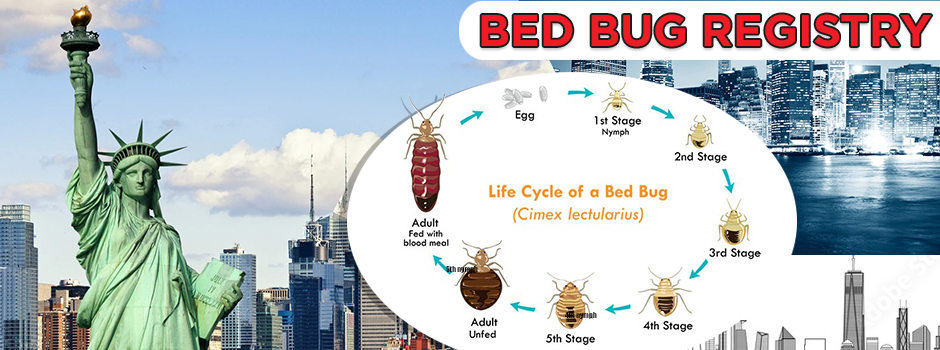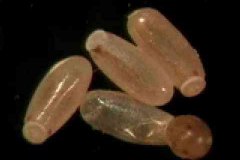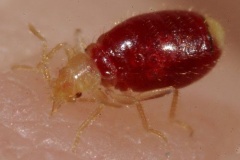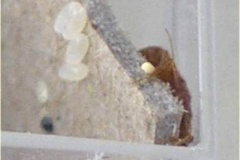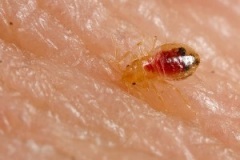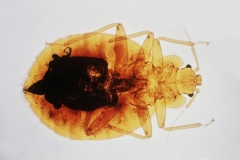Freehold: Corporate office Phone: 800-362-2282 Fax: 732-577-1263
Flanders: Phone: 973-584-2552 Fax: 973-584-2455
Somerville: Phone: 908-730-6565 Fax: 908-823-0354
Clover Mites Clover mites sometimes invade homes in enormous numbers, in early spring and late autumn, overrunning floors, walls, drapes, window sills and furniture, even occasionally getting into beds and clothing. They may become troublesome in hospitals, nursing homes, apartments, food processing facilities, etc.
Bag Worms Bagworm larvae damage their hosts by feeding on the foliage. Heavy infestations can completely defoliate small plants. Defoliation usually kills hosts such as red cedar and other junipers.
Fleas The cat flea, is one of the most abundant and widespread species of flea on Earth.
Ticks Ticks are blood-feeding parasites that are often found in tall grass where they will wait to attach to a passing host.
Gypsy Moths The hatching of gypsy moth eggs coincides with budding of most hardwood trees. When population numbers are dense larvae feed continuously day and night until the foliage of the host tree is stripped. Then they crawl in search of new sources of food.
Eastern Tent Caterpillar Eastern tent caterpillar nests are commonly found on wild cherry, apple, and crabapple, but may be found on hawthorn, maple, cherry, peach, pear and plum as well. While tent caterpillars can nearly defoliate a tree when numerous, the tree will usually recover and put out a new crop of leaves. The silken nests are built in the crotches of limbs and can become quite large.
Yellow Jackets Wasps become a problem only when they threaten to sting humans. One of the most troublesome of the social wasps is the yellow jacket. Yellow jackets, especially ground and cavity-nesting ones, tend to defend their nests vigorously when disturbed. Defensive behavior increases as the season progresses and colony populations become larger while food becomes scarcer.
Bees Bees play an important role in pollinating flowering plants, and are the major type of pollinator in ecosystems that contain flowering plants. Removal by recommended bee keepers is most common control method.
Bald-faced Hornets They are best known for their large football-shaped paper nest, which they build in the spring for raising their young. These nests can sometimes reach 3 feet tall. Bald-faced hornets are protective of their nests and will sting repeatedly if the nest is physically disturbed. They are more aggressive than both wasps and yellow jackets.
Cicada Killer Wasps These are large, solitary, ground dwelling, predatory wasps. They are so named because they hunt cicadas and provision their nests with them. The cicada killer wasps attract attention due to their large size, the burrows that they dig in home lawns, and their buzzing flights over the lawn. In spite of their large size, the wasps usually ignore people but they can give a painful sting if bothered.
Subterranean Termites The eastern subterranean termite is the most widespread termite in the U.S., found throughout the eastern, Midwestern and southern states. The far-reaching distribution of this pest leads experts to estimate it causes more structural damage nationwide than any other termite species.
Carpenter Bees Carpenter bees tunnel into wood to lay their eggs. Bare, unpainted or weathered softwoods are preferred especially redwood, cedar, cypress and pine. Painted or pressure-treated wood is much less susceptible to attack. Common nesting sites include eaves, window trim, fascia boards, siding, wooden shakes, decks and outdoor furniture.
Carpenter Ants Carpenter ants, vary in size and color but are usually large (- inch) and blackish. Besides being objectionable by their presence, carpenter ants damage wood by hollowing it out for nesting. They excavate galleries in wood which have a smooth, sandpapered appearance. Wood which has been damaged by carpenter ants contains no mud-like material, as is the case with termites.
Wood Destroying Beetles There are a number of small beetles that attack wood. Most attack wood that is alive (i.e., trees) or green lumber,) but a few will attack seasoned wood, like furniture, flooring, paneling, and stored lumber.
Household Ants Ants are among the most prevalent pests in households. They are also found in restaurants, hospitals, offices, warehouses, and other buildings where they can find food and water.
Carpenter Ants Several species of carpenter ants are capable of damaging wood in buildings and other structures. They will enter buildings in search of nesting sites or moisture and can build nests containing several thousand ants. Typically, the nests they construct indoors are satellites of a larger, parent nest located outside in a live or dead tree, a woodpile, or landscaping materials.
Bed Bugs Bed bugs are small parasitic insects. The term usually refers to species that prefer to feed on human blood. In the developed world, bed bugs were largely eradicated as pests in the early 1940s, however have increased in prevalence since about 1995. Because infestation of human habitats has been on the increase, bed bug bites and related conditions have been on the rise as well
Mice The house mouse is remarkably well-adapted for living year-round in homes, food establishments and other structures. Homeowners are especially likely to notice mice during winter. Once mice become established inside a home, they can be extremely difficult to control. Although most people consider mice less objectionable than rats, mice are more common and cause significantly more damage.
Rats The Norway rat, also called the brown rat or sewer rat, is a destructive pest found in urban and suburban neighborhoods. These rodents eat and contaminate food, damage buildings and other property by their gnawing and burrowing, and may spread diseases that affect people and pets. Norway rats are husky, brownish rodents that weigh about 11 ounces.
Voles A vole is a small rodent resembling a mouse but with a stouter body, a shorter hairy tail, a slightly rounder head, smaller ears and eyes. Voles will often eat succulent root systems and will burrow under plants or ground cover they are particularly fond of and eat away until the plant is dead. Bulbs in the ground are another favorite target for voles.
Household Flies These pests breed in animal wastes and decaying organic material from which they can pick up bacteria and viruses that may cause human diseases. In addition, adult stable flies (sometimes called "biting flies") feed on mammalian blood and can give a painful bite.
Drain Flies Drain flies sometimes appear suddenly and mysteriously, becoming a nuisance in both homes and sewage disposal plants. Adult flies may become so numerous indoors that they congregate at windows, darken lamp shades at night, fall into food and accumulate around showers, bathtubs, sinks and floor drains, especially in the basement.
Bottle Flies Bottle flies usually have a metallic blue or green color or both on the thorax and abdomen. Flies can breed on dead rodents and birds in attics or wall voids of houses. They usually breed in meat scraps, animal excrement, and decaying animal matter around houses. The adult flies are quite active inside and are strongly attracted to light.
Fruit Flies Fruit flies are nuisance pests and contaminators of food. Fruit flies usually breed in fruit, dirty garbage containers, or slime in drains.
Stink Bugs Most stink bugs are herbivorous and use their piercing and sucking mouthparts to feed on plant juices. When handled or disturbed, stink bugs are able to secrete a bad-smelling, bad-tasting fluid from pores on the sides of their bodies. If stink bugs have already entered a home or building, a vacuum cleaner can aid in the removal of live or dead stink bugs. The bag must be removed to prevent odor from permeating the area.
Boxelders Boxelder bugs are primarily a nuisance because they enter homes and other buildings, often in large numbers. Fortunately, they do not bite people and are essentially harmless to property. When abundant, they can stain walls, curtains, and other surfaces with their excrement. Adult boxelder bugs are about 1/2-inch long, black with orange or red markings, including three stripes.
View post:
bed bugs removal treatment in New Jersey - Pest ID

 Residence
Residence  Location
Location 
